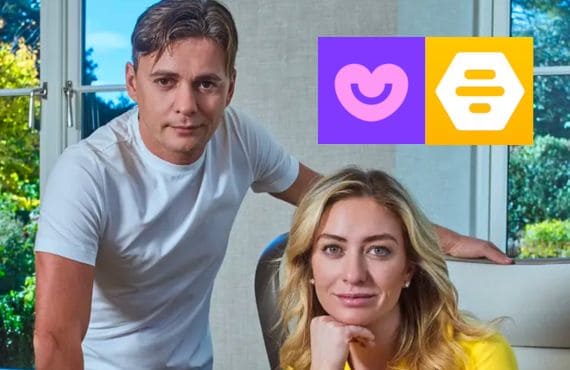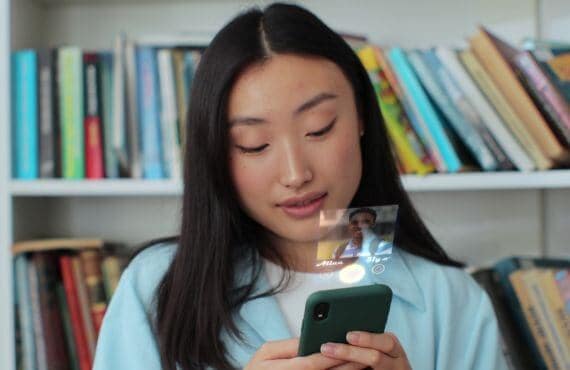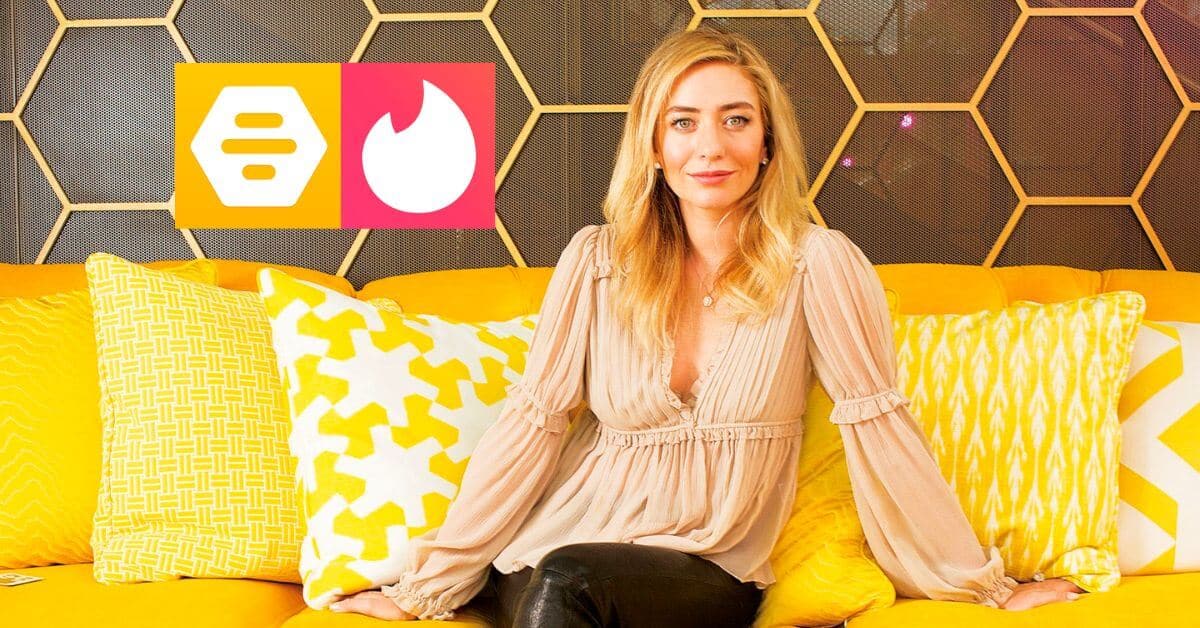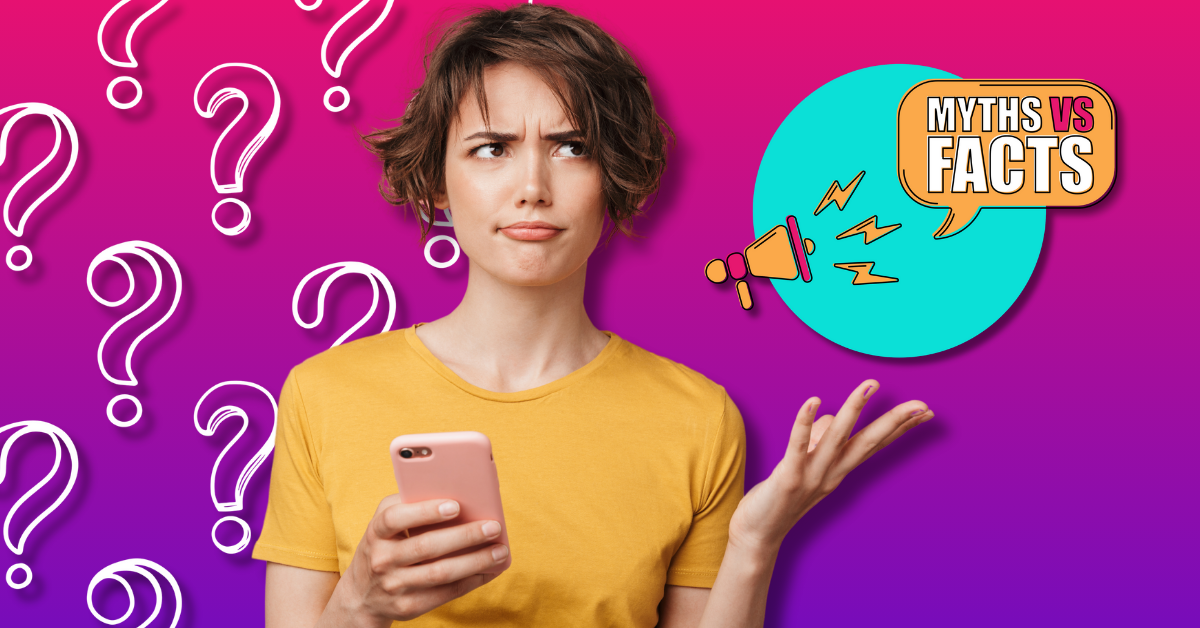Have you ever wondered how your favorite dating apps got created? Have you ever thought about the motivation that started these billion-dollar industries? Or, have you ever stopped to consider why some apps offer certain features while others neglect them?
You may be like us and study the differences between top dating apps and wonder why some apps maintain specific core programs but differ in other ways.
While we can’t answer all your dating app questions today, we want to do a deep dive into the beginning of one of our favorite dating apps on the market: Bumble.
It’s no secret that Bumble is one of the best dating apps for finding long-term love. In 2022, Bumble had over 40 million active users a month. The year before, the app saw over 45 million yearly active users. Bumble is constantly sitting in the top seven dating apps of all time.
Although the app shares many basic similarities with Tinder and other swipe-style platforms, Bumble places a greater emphasis on safety and providing a welcoming and encouraging environment for all its users.
But what inspired Bumble’s start, and why is it still one of the most unique and empowering dating apps in the game?
The Origins of Bumble
If you’ve ever wondered why Tinder and Bumble have similar appearances and a suspicious number of things in common, the reason is Whitney Wolfe Herd.
Herd started working at a tech incubator right after she got out of college at 22. It was there that she and her team created the app now known as Tinder.
While being a part of such a powerful and impactful company like Tinder is worthy of bragging rights, Herd felt uneasy about the app.
Tinder had a reputation for not being the safest dating app. Online dating was still in its infancy, and the platform struggled to monitor its users while ensuring the app ran smoothly at the same time.
Herd was also learning a hard lesson about what it meant to be a woman trying to date in the modern world.
In a recent interview on The Goop Podcast, Whitney Wolfe Herd described the struggles she faced while she and her team were building Tinder.
She stated, “There’s an interesting through-line here because I was dealing with the perils of dating in the real world [while I was creating Tinder]… I remember that it would have been considered a sin if I had texted a guy first or if any of my girlfriends had approached a guy in a bar… those were the rules… but it pissed me off, and I always remember saying this isn’t fair.”
That feeling of unfairness constantly reared its ugly head as Herd worked at Tinder. The reports her team was getting about abuse and the new avenue of cyberbullying that Tinder provided for many people never sat well with her.
She continued, “So we go on to build Tinder, it becomes this successful business, but through that growth came some repavement opportunities. I identified that these products that I myself was contributing to, for better or for worse, we weren’t putting women first; we weren’t thinking about women. We took a framework that existed offline, which was flirting, dating, and connecting, and quite literally translated it digitally, but we didn’t reengineer the rules through that. It was just this kind of transfer of behavior.”
As a woman, Herd knew the ins and outs of dating and the fears and dangers that often resulted from meeting someone in the real world. She also knew that just because the physical element of meeting your date in person was removed from the equation when her team moved the idea of dating to an online platform didn’t mean that the dangers that men presented in these situations would disappear as well.
While she doesn’t like to hark on this aspect of her origin story, Herd was abused by the executive of Tinder, who just so happened to also be her boyfriend. When she spoke out and attempted to sue for sexual harassment, she was promptly evicted from her co-founder position and forced to figure out the next step on her own.
Herd’s story of how she was introduced to the world of online dating and still rose from the ashes of abuse is a testament to her strength and the power of her vision, but she also doesn’t want to focus on the past too much.
At the end of the day, Herd decided that leaving Tinder wasn’t going to be the devastating end to her career many people expected. Instead, she reworked the app to create an avenue to skyrocket her career while also fixing the problems that seemed glaringly obvious to her.
Bumble’s Beginnings
Herd left Tinder in April 2014. Once she had time to heal and reflect on the past few months and what she had learned from her experience with the company and her life journey, she started to conceptualize the idea that soon would become Bumble.
Her first idea for the app was to create a female and compliments-only platform where women could hype each other up and celebrate one another’s victories. While this app could have been relatively successful, and there is a need for not only female empowerment but also a women-only app, she knew that she could do better and push the boundaries of her imagination even further.
In June of that year, just two months after she left Tinder, she met with her old business partner, who would help convince her to turn that concept into a dating website, which would soon be called Bumble.
Bumble launched that December.
The journey that led Herd to create Bumble was more complex than that summary suggests, and she did have a large amount of help on the way.
Andrey Andreev, the founder of one of Europe’s most successful dating apps, Badoo, fought for Herd’s ideas to become a reality and pushed her friend into making the best decision of her life.
While Herd knew that she could make a massive impact on the online dating world, she stayed firm in her resolution to always keep women at the helm, no matter what that meant for the success of the app or what that had to look like when the rubber met the road.

The early days of marketing for Bumble looked like Herd and Caroline Roche, Herd’s sorority sister, going around SMU’s campus and giving out goodies that shared the app’s name long before it even hit the App Store. Because of this genius marketing technique, people all around the United States were already excited about Bumble before it even released, leading the app’s launch date to be one of the most successful ones in history.
While the app’s humble beginnings might have made anyone give up and call it quits with every bump in the road, Herd was able to take what could have been a detrimental and traumatic tragedy and turn it into one of the most empowering success stories that any app has ever been founded on.
The Psychology of Bumble
It’s no secret by now that Bumble was the first app to give women all the power when it comes to initiating a relationship, but there is still some mystery of why the app works in the way it does.
For those of you who have never used the Bumble dating app, allow us to explain one of the main differences that set Bumble apart from other dating apps.
On most dating apps, users are allowed to swipe on each other’s profiles to their hearts’ content. Of course, if you choose a free version of your dating app, your swipes and likes might be more limited than if you go premium, but that’s beside the point.
Once you’ve swiped right on a profile, indicating that you’ve liked someone or that you’re interested in the possibility of pursuing a relationship with them, a notification might pop up saying that you’ve matched with that person. This means that both of you have swiped right and shown some interest in one another’s profiles.
The next stage of this process is to message the person with whom you’ve matched. This is where Bumble differs from any of the other dating apps that are topping the chart right now.
If you’re using another app, like Tinder or Hinge, anyone can message the other person first. And frankly, if you’re using a hetero-normative point of view in this situation, the man is often expected to be the one who messages the women first.

In fact, in a study conducted on the behaviors and expectations of Tinder, only 1.4% of women say that women should send the first message. Even though the men’s responses to this question were more optimistic, they were still pretty low at 9.8%.
Of course, the woman can message first if she wants to, but it’s less common on apps like Tinder.
While some women like this setup and enjoy being able to sit back and get courted by men peacocking in their messages, trying to get the most attention and interest from the women, this open-ended opportunity to talk to anyone and everyone you match with online has led to many resorts of abuse, bullying, and discomfort on apps like Tinder.
When Whitney Wolfe Herd Created Bumble, she knew that she wanted to create a safe space for women to find love and feel seen online. While her first creation, Tinder, saw a lot of men coming off as aggressive or annoying, she made sure that Bumble would feature much less of that behavior.
Herd attributes the aggressive courtship and suggestive messages that women were prone to get on Tinder to psychology. She says, “A lot of the aggressive toxic behavior we see in online and offline dating is actually a function of rejection.” She says that the hetero-normative rules that suggested men needed to message first caused more aggression, as they knew that they were automatically being compared to everyone else in the woman’s inbox.
Herd explains, “When you reduce that aggressiveness by saying, ‘Hey, it’s okay, you don’t have to be aggressive, you don’t have to be rejected, you’re not going to get ignored by 50 women,’ it just deflates a lot of things. People can relax a little bit.”
Herd knew that eliminating men’s ability to message women first would not only lessen the chance of aggressive and abusive communication but also make the woman feel more capable and powerful in the decision-making process of the relationship.
While this women-message first might not be everyone’s cup of tea, especially when you’re the woman, and you feel the pressure of having to create original and witty first messages to send to all of your matches, it drastically reduces any danger and fears that women are so used to experiencing when they’re dating in today’s day and age.
Bumble Today
As we outlined in the first section of this article, Bumble didn’t just rise to fame and then drop off in its performance and success rates, as many apps tend to do in today’s economy and market. Instead, the app is constantly getting the praise, accolades, and attention it deserves for all of the work the team has done to create the dating platform the world needs.
Not only is Bumble one of a kind in the way that it celebrates and empowers the woman to take control of her dating life, but the principles that govern Bumble’s company are doing the same, hiring women to fill in over 80% of their positions and constantly looking for new and innovative ideas that they can use to ‘break the internet’ and redefine the dating world to be a safe and thriving place for women to thrive.
Once Whitney Wolfe Herd launched the Bumble app, she became the youngest woman to ever take a company public. But she didn’t stop there, and she doesn’t seem to be planning on resting on her accolades any time soon. Instead, Herd is constantly on her app, swiping, checking to see if there need to be improvements made, and talking to the users who are actively experiencing her creation.
Herd and her team seem to be constantly working to ensure that Bumble is not only a success story for its time but that the app continues to break down the prehistoric walls that its predecessors put into place and break the rules of what a dating app should look like and should be able to do.
And instead, it’s become a groundbreaking and stunning invention where everyone feels safe, heard, and seen. And although those feelings ought to be mainstream by now, and all dating apps across the board should seek to create this kind of environment, it is still not the norm, and it is one of the many features that makes Bumble stand out from the crowd.
Herd set out to create an app where women could feel empowered, seen, and heard. Bumble not only checks all of those boxes, but continues to break down barriers, exceed expectations, and redefine what online dating should feel and look like for users worldwide.




